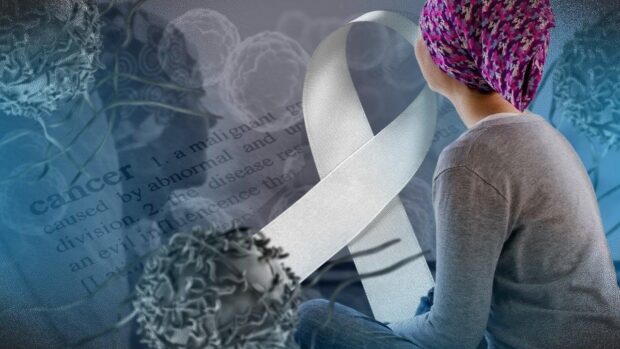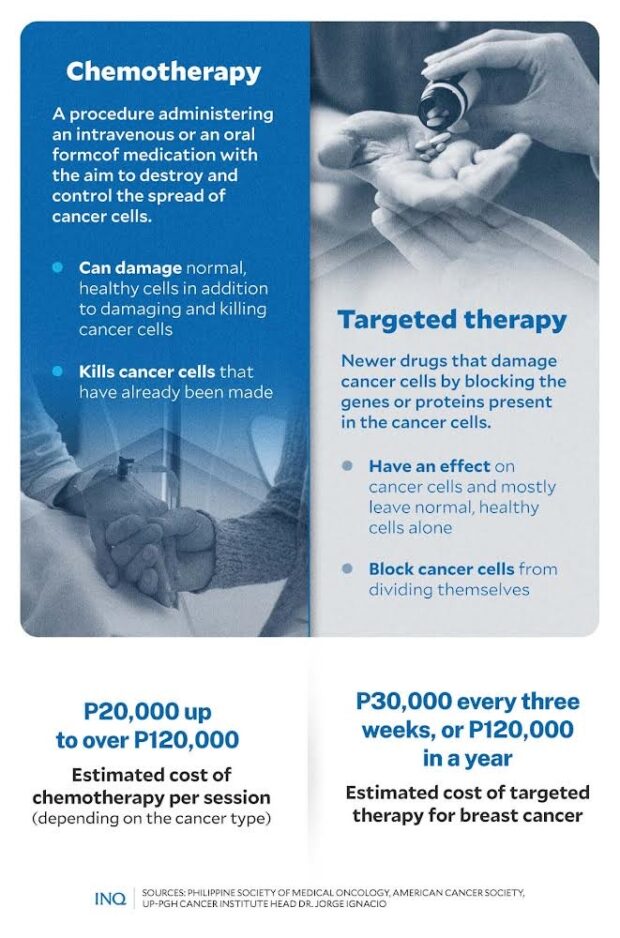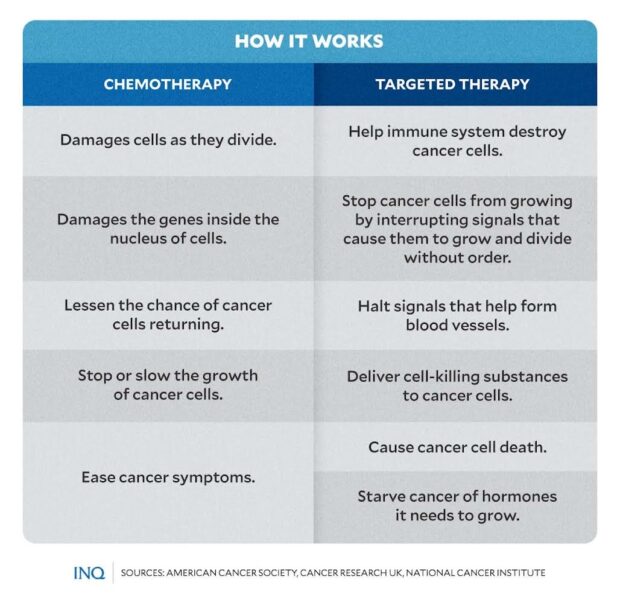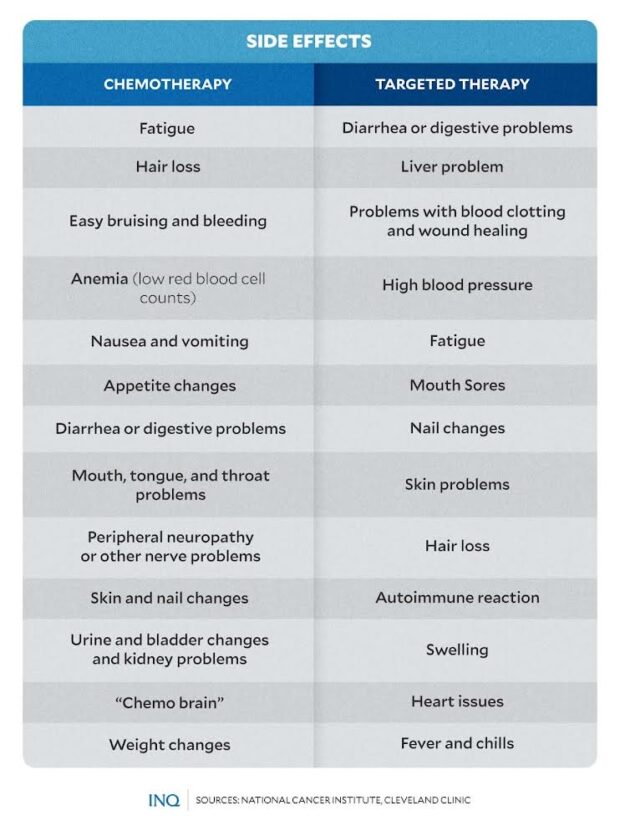Traditional chemo, targeted therapy: What’s the difference?
MANILA, Philippines—In the past years, much has been achieved in finding better care for cancer patients. Not long ago, newer treatment options—aside from traditional therapy—has been made available for patients in the Philippines.
In the Philippines, where breast cancer is the leading type of cancer and is the most common cancer among women of all ages, searching for better treatment against the Big C has been a huge priority among health experts and cancer support groups.
Common cancer treatments include radiation therapy, immunotherapy, hormone therapy, and chemotherapy. The last, according to the US-based Mayo Clinic, is the most often used treatment method.
At the UP-Philippine General Hospital (UP-PGH) Cancer Institute, which offers quality comprehensive cancer treatment, charity inpatients and outpatients receive chemotherapy mainly through an IV drip.
Since a single session of IV chemotherapy takes from 20 minutes to several hours—on top of that, the UP-PGH Cancer Institute has a limit of 100 IV chemotherapy per day—lines usually form outside the hospital’s Cancer Institute building.
Article continues after this advertisementREAD: Long lines, lengthy treatment wear out PH cancer patients
Article continues after this advertisementAside from traditional chemotherapy and other standard treatment options, many countries have begun offering a newer type of treatment called targeted therapy. In the Philippines, targeted therapy has been an available treatment option for breast cancer patients since 2011.
To understand more about these treatment options, in this article, INQUIRER.net will detail the difference between traditional chemotherapy and targeted therapy.
Chemotherapy
According to the American Cancer Society, the term “chemotherapy” or “chemo” is often used when referring to medicines or drugs that treat cancer. However, not all medications used to treat cancer work in the same way.
“Chemo is considered a systemic treatment because the drugs travel throughout the body, and can kill cancer cells that have spread (metastasized) to parts of the body far away from the original (primary) tumor,” the American Cancer Society explained.
“This makes it different from treatments like surgery and radiation,” it added.
For traditional or standard chemotherapy, patients are given drugs that are cytotoxic or can kill tumor cells.
The Philippine Society of Medical Oncology (PSMO) noted that medical oncologists or cancer specialists use chemotherapy in different ways with different goals, such as:
- using chemotherapy before the surgery or radiation therapy to shrink the tumor;
- using chemotherapy after surgery or radiation therapy to kill the remaining cancer cells which the naked eye cannot see;
- using chemotherapy as the primary treatment;
- using chemotherapy when the tumor comes back;
- using chemotherapy when cancer spreads to other parts of the body (metastatic cancer) and control the symptoms of the tumor complications.
An oncologist also determines a patient’s chemotherapy plan depending on many factors, including the type of cancer, stage of cancer, and the patient’s age, general health, body weight, and previous cancer treatments.
The specialist also considers the possible side effects of each drug used during chemotherapy on patients and other existing medical conditions that patients have.
Chemotherapy drugs are most commonly administered as an injection into the bloodstream, through a vein, or an intravenous infusion or drip. For some patients, chemotherapy drugs are given orally as tablets or capsules.
These methods, according to Cancer Research UK, allow the drugs to circulate all around the body in the bloodstream and reach cancer cells almost anywhere in the body.
There are also less common ways of having chemotherapy, such as through injections into the muscle (intramuscular), injections under the skin (subcutaneous), injected directly into arteries (intraarterial), injected into the spinal canal (intrathecal), and as a cream.
Targeted therapy
Targeted therapy, from its name, refers to the type of cancer treatment that uses drugs designed to target cancer cells without affecting normal cells.
According to the US National Cancer Institute, since targeted therapy targets the proteins that control how cancer cells grow, divide, and spread, it is considered the foundation of precision medicine.
“Targeted therapy is an important type of cancer treatment, and researchers will develop more targeted drugs as they learn more about specific changes in cancer cells. But so far, only a few types of cancers are routinely treated using only these drugs,” the American Cancer Society explained.
“Most people getting targeted therapy also need surgery, chemotherapy, radiation therapy, or hormone therapy,” it added.
READ: Targeted therapy makes waves as brightest hope for cancer treatment
Some examples of targeted therapy drugs are trastuzumab for breast cancer, osimertinib for lung cancer, and rituximab for lymphoma.
Targeted therapy drugs can be given to select cancer patients intravenously, subcutaneously, or orally.
The duration and frequency of receiving targeted therapy treatment depend on factors such as the patient’s type of cancer and how advanced it is, the type of targeted therapy, and how the patient’s body reacts to the treatment.
“You may have treatment every day, every week, or every month. Some targeted therapies are given in cycles. A cycle is a period of treatment followed by a period of rest. The rest period gives your body a chance to recover and build new healthy cells,” said the US National Cancer Institute.
Chemotherapy vs targeted therapy
While traditional or standard chemotherapy is still the best way to treat many cancers, different kinds of drugs—such as those offered for targeted therapy treatment—may work better for others.
According to experts, the difference between traditional chemotherapy and targeted therapy is mainly based on how the two treatments work against cancer cells.
While both treatment types are considered effective methods for cancer therapy, chemotherapy can kill normal cells, aside from eliminating cancer cells. Meanwhile, normal cells can survive the targeted therapy.
“The good news is that most normal cells will recover from the effects of chemo over time,” the American Cancer Society explained.
Aside from killing cancer cells, targeted therapy drugs are also known to block cancer cells from dividing themselves. It also prevents cancer cells from growing. Traditional chemotherapy, on the other hand, kills cancer cells that have already been made.
Other unique qualities of targeted therapy include:
Encouraging the immune system to attack cancer cells.
Stopping cancers from growing blood vessels.
Helping other treatments such as chemotherapy to reach cancer cells directly.
Traditional chemotherapy damages cells as they divide or the genes inside the nucleus of cells. Studies have shown that this type of treatment helps lessen the chance of cancer cells returning and eases cancer symptoms by shrinking tumors that are causing pain and other problems.
Side effects, efficacy
Since traditional chemotherapy drugs also kill or slow the growth of normal and healthy cells, the treatment causes several side effects. Among the most common side effects are fatigue, feeling sick, and diarrhea—which might occur when patients take chemotherapy drugs.
Side effects such as hair loss, bruising and bleeding, anemia, weight changes, “chemo brain” or memory problems, and skin issues are also usually observed among cancer patients undergoing traditional chemotherapy.
However, normal cells can replace or repair the healthy cells damaged by chemotherapy. Most side effects of chemotherapy are also found to disappear once the treatment is over.
“What we used to know is the typical chemotherapy, which causes side effects such as balding or extreme hair loss, fatigue, and difficulty in recovering after treatments,” Kasuso Philippines Foundation for Breast Care Inc. volunteer Aileen Antolin said in Filipino.
“What’s good with targeted therapy is that it has no side effects. Patients don’t experience major hair loss. They don’t [feel sick] after their treatment,” she added.
READ: Roadblocks keep better treatment out of breast cancer patients’ reach
According to PSMO, targeted therapy has fewer side effects compared to traditional chemotherapy. Among its usual side effects include diarrhea, which is often mild.
Depending on the drug used for the treatment, targeted therapy can also cause fatigue, mouth sores, rashes or dry skin, high blood pressure, and problems with blood clotting and wound healing.
Similar to traditional chemotherapy, the US National Cancer Institute said most side effects of targeted therapy go away after the treatment ends.
The success rate of both traditional chemotherapy and targeted therapy varies significantly. The results depend on the patient’s cancer type and stage.
“With some types of cancer, most people are cured by chemotherapy, [while] with other types of cancer, fewer people are completely cured,” Cancer Research UK said.
In some cancer patients, if a cure is unlikely, doctors may still suggest chemotherapy to shrink the cancer, relieve their symptoms, and give the patient longer life by controlling the cancer or putting it into remission.
Meanwhile, in the Philippines, Antolin noted that there has been “great success” in terms of the prognosis of breast cancer patients who underwent targeted therapy treatment.
TSB
RELATED STORIES:
To aid more PH cancer patients gov’t urged to revisit programs, boost cancer funds
More needs to be done: Better breast cancer treatment, care pushed
High treatment costs a death sentence for many PH cancer patients
Access to new cancer medicines remains limited for poor patients—experts



